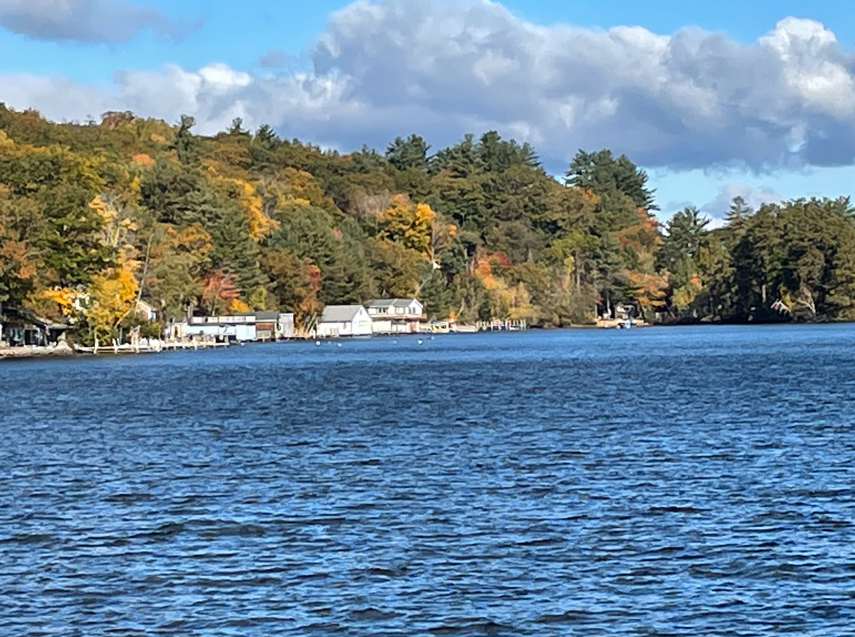By PAULA TRACY, InDepthNH.org
GILFORD – With the water temperature a pleasant 70 degrees, it could be a good time for a swim in Lake Winnipesaukee as the state has taken down all cyanobacteria warnings and watches for the Big Lake Wednesday.
However, new warnings were issued Wednesday for Little Lake Sunapee in New London and Webster Lake in Franklin. Webster Lake has had problems over the years with this blue green algae which can cause illness in humans and pets, but Little Lake Sunapee has had little exposure to the problem in the past, though it did have a bloom break out in 2023.
But in its cyanobacteria update for Sept. 18, the Department of Environmental Services’ harmful algal bloom program (HAB@des.nh.gov) reported that all the cyanobacteria watches or warnings have been removed from Winnipesaukee including for Governor’s Island, The Broads, Wolfeboro, Alton and Tuftonboro areas.
Some had been up since before Labor Day Weekend.
“There are no longer any active cyanobacteria areas listed for Lake Winnipesaukee,” said the advisory emailed to those who are watching the historically high number of blooms on the 72-square mile lake this summer.
“Some low density cyanobacteria (especially Gloeotrichia) may persist in the system into the fall season. If you observe persistent dense accumulations, please report through the bloom report form. As always, perform a self risk assessment prior to recreating, and stay out of areas with visual discoloration or unusual growth until the water clears again,” it read.
A warning had been issued for The Broads, one of the deepest sections of the lake off Governor’s Island and between Wolfeboro.
The warning was issued 8/27/2024 and remained until it was “clear” on 9/5/20 with no new bloom reports received.
In Gilford’s heavily populated Governor’s Island area the status was also clear after being issued the same date.
While a medium density Gloeotrichia bloom report was received for between Steamboat and Birch Islands, the state was reporting the general area “clear” on Wednesday.
In the Wolfeboro area on the lake’s eastern side, a warning which was issued 8/19 is now down.
However, a low density of the form of cyanobacteria known as Gloeotrichia was received for Winter Harbor.
Also on the eastern shore in the Tuftonboro area stubborn watches and warnings since Aug. 20 were no longer up as of Wednesday with no new bloom reports received.
In the southern end at Alton Area the status was also “clear” after a watch was issued Aug. 19.
There are, however, a list of other lakes and ponds in the state which do have current cyanobacteria warnings and watches.
At an Executive Council meeting Aug. 30, Gov. Chris Sununu criticized Department of Environmental Services Commissioner Bob Scott over the department’s cyanobacteria messaging.
Saying “this is not (the movie) ‘Jaws,’” Sununu ripped into Scott when a number of blooms were reported on Lake Winnipesaukee in time for the busy Labor Day holiday weekend.
“This is not toxic. This does not kill people….so please, work with your department, get the messaging straight, work with the legislature, make sure some of these solutions are there, but please make sure that people understand, this is not some deadly bacterial bloom that should shut down beaches or anything like that,” Sununu told Scott.
After Sununu’s remarks, state Rep. Rosemarie Rung, D-Merrimack, called Sununu’s downplaying cyanobacteria’s health effects “incredibly irresponsible.”
According to the DES website: “Cyanobacteria blooms can be harmful to pets, livestock, wildlife and people. For more information about human health effects of harmful algal blooms, visit the U.S. Environmental Protection Agency website.”
The Healthy Swimming Mapper for a list of all watches and warnings, which can change frequently, can be found here: https://www.arcgis.com/apps/dashboards/8d84a6b03acb4efaab571b222c78447b
Current cyanobacteria watches (alerts) are in effect for Pool Pond, Rindge; Province Lake, Effingham and Wakefield; Jenness Pond, Northwood; Duncan Lake, Ossipee; Bow Lake, Strafford; and Lake Wentworth, Wolfeboro.
Current cyanobacteria warnings, which are issued for generalized areas where harmful cyanobacteria blooms have been recently identified, but the whole waterbody may not be simultaneously impacted, include Lake Ivanhoe, Wakefield; Warren Lake, Alstead; Lake Monomonac, Rindge; Locke Lake, Barnstead; Baptist Pond, Springfield; Tucker Pond, Salisbury; Arlington Mill Reservoir, Salem; White Oak Pond, Holderness; and Sunrise Lake, Middleton, in addition to Little Lake Sunapee in New London and Webster Lake in Franklin which were mentioned above.





